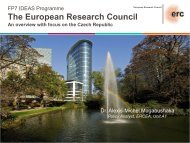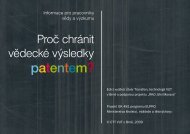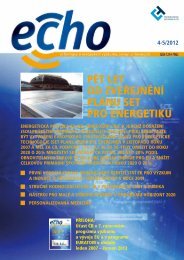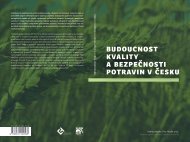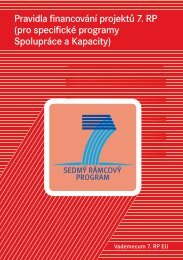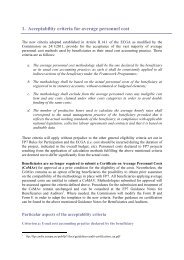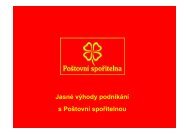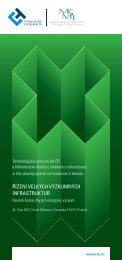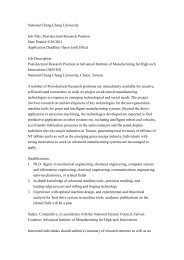Name, Surname
Name, Surname
Name, Surname
You also want an ePaper? Increase the reach of your titles
YUMPU automatically turns print PDFs into web optimized ePapers that Google loves.
• Soil related data for Danube Basin extracted from a range of in-house pan-European assessments will<br />
be made available. For example, key soil properties, organic matter, estimated soil erosion, soil sealing<br />
intensity, salinisation, land productivity dynamics, etc. It should be noted in almost all cases, individual<br />
countries have more detailed data that the JRC. However, the information at national level is very<br />
heterogeneous, which makes large area assessment difficult. In many cases, the data held by the JRC<br />
are the only pan-Danube level information. In the medium-term, a ‘state of the environment’ style<br />
report on the soils of the Danube Basin, with collaboration of Member States (as a contribution to the<br />
State of the Environment Report for 2015)<br />
• Information on mini hydropower generation potential will be incorporated as background for the<br />
modelling and scenario analyses. The assessment methodology is under validation for assessing<br />
possible locations and productivity of mini-hydro power plants. Information on water need from<br />
bioenergy production, following the IEA-bioenergy approach that JRC has contributed to develop.<br />
♦ Hydro-economic modelling<br />
The calibration and validation of a hydro-economic model for the Danube region coupling water quantity<br />
and quality models with an economic model assessing the damage due to water shortages and with an<br />
optimisation model based on multi-criteria approaches will be undertaken. Based on a multi-criteria<br />
approach, the model will allow the selection of measures affecting water availability and demand based<br />
both on environmental and economic considerations. It will include an assessment of water footprint for<br />
energy and agricultural production in the Danube Region taking into account also trade options. This Work<br />
Package will build on the development and applications made by the JRC in the preparation of the Impact<br />
Assessment of the EU Water Blueprint for all Europe. Follow up modelling to the Blueprint needs to be<br />
streamlined at river basin scale, such as the Danube, to more closely reflect the reality in regions.<br />
• The suite of biophysical models part of the JRC Integrated Water Modelling Platform will allow<br />
accounting for the variability of the quantity and quality of water resources. Making use of the spatial<br />
database developed in the first above-mentioned work package, all hydrological elements in the<br />
Danube river basin will be linked to a network of sources and demand sites for energy production, for<br />
urban and industrial water uses, for ecological and environmental flows and agricultural needs. The<br />
latter will be based on specific modules accounting for river basin scale agricultural practices and their<br />
impacts on water. Water withdrawals and return flows will be developed for each of these demand<br />
nodes, or determined using empirical relations between water and type of productive uses.<br />
• Simulations will be carried out to assess the effects of water-retention measures, water-saving<br />
measures, and nutrient-reduction measures on several hydro-chemical indicators, such as the Water<br />
Exploitation Index (WEI), Environmental Flow indicators, the 50-year return period river discharge as an<br />
indicator for flooding, and economic losses due to water scarcity for the agricultural sector, the<br />
manufacturing-industry sector, the energy-production sector and the domestic sector.<br />
• Water resource use and management involve multiple conflicting objectives and criteria. Selecting the<br />
best appropriate combination of water management uses from numerous objectives is difficult and<br />
challenging as solutions require compromises that are acceptable by all potential stakeholders. Multi-<br />
Criteria Decision Models provide a systematic mean for comparing tradeoffs and selecting alternatives<br />
that best satisfy the decision maker’s objectives. Taking economic and environmental constraints into<br />
account, the optimisation model will allocate available water to all end users while ensuring the best<br />
tradeoffs for economic and environmental sustainability.<br />
♦ Scenario analyses<br />
This Work Package will carry out analyses of future scenarios of water demand and supply, an assessment<br />
of tradeoffs between alternative schemes of water allocation across the agriculture and energy sectors, and<br />
the selection of optimal management options to reduce vulnerability of water ecosystems and ensure a<br />
sustainable agricultural production and the provision of ecosystem services. Scenarios will be run on the<br />
basis of macroeconomic trends involving changing land use and climate conditions for 2030 and 2050<br />
EUROPEAN COMMISSION<br />
Joint Research Centre (JRC)<br />
5



